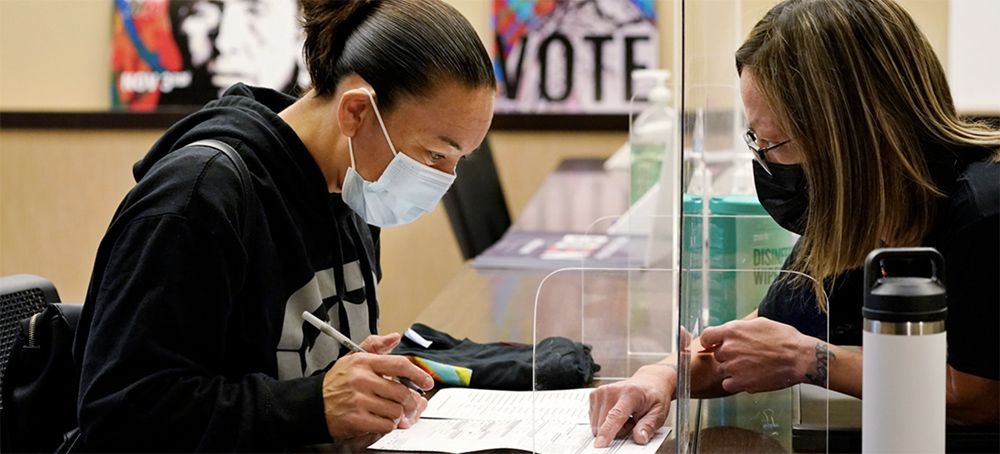6 Things You Should Know About the 2021 Native American Voting Rights Act
Jessica Douglas High Country News Lummi Tribal member Patsy Wilson fills out her ballot with assistance from volunteer Kelli Jefferson on Nov. 3, 2020, in Lummi Nation, Washington. NAVRA will allow tribal members to register, pick up and drop off their ballots at designated tribal buildings. (photo: Elaine Thompson/AP)
13 September 21
Lummi Tribal member Patsy Wilson fills out her ballot with assistance from volunteer Kelli Jefferson on Nov. 3, 2020, in Lummi Nation, Washington. NAVRA will allow tribal members to register, pick up and drop off their ballots at designated tribal buildings. (photo: Elaine Thompson/AP)
13 September 21
Indigenous communities face disproportionate barriers to voting, but the act would help protect this important right.
The bipartisan legislation follows the U.S. Supreme Court’s decision on a prominent voting rights case. In Brnovich v. DNC, the court upheld two Arizona voting policies that disqualify any ballot cast in the wrong precinct, as well as a 2016 law that made it a felony for anyone but a family or household member or caregiver to return another person’s mail ballot. Ballot harvesting or collecting is often used by get-out-the-vote groups to increase Indigenous turnout. Activists and attorneys say the July ruling will make it harder for people of color — especially Indigenous populations — to vote.
NAVRA seeks to fulfill the federal government’s trust responsibility to protect Native Americans’ right to vote by tackling the unique challenges that Indigenous communities face. “We have to address ongoing discriminatory policies at the state and local levels,” Native American Rights Fund staff attorney Jacqueline De León (Isleta Pueblo) said. “We need a federal policy that sets a baseline of access and prevents continuing abuses.”
These six provisions of the proposed legislation are intended to increase Indigenous voters’ access to the ballot box.
1) NAVRA improves access to voter registration, polling places and drop boxes in Indian Country.
The law requires states to designate at least one polling place and registration site for both state and federal elections in every precinct in which tribal voters reside on tribal lands. NAVRA also requires federally funded or operated facilities, such as Indian Health Services, to serve as designated voter registration sites.
2) It mandates the acceptance of tribally or federally issued IDs where IDs are required.
Some states have restrictive voting ID policies that place a disproportionate hardship on Indigenous voters. In North Dakota, for example, the Spirit Lake Nation and the Standing Rock Sioux Tribe sued over a state policy that required voters to present identification that includes a residential street address, even though many tribal members live on reservations that lack residential street addresses or have to use P.O. boxes for mail service. NAVRA authorizes the use of tribal IDs for voting purposes.
3) It permits tribes to designate buildings to use as addresses for registration.
This would allow tribal members without a residential address, stable address or mail delivery to register, pick up and drop off their ballots at designated tribal buildings.
4) The law will establish Native American voting task forces.
NAVRA would establish state-level voting task forces to address some of the issues unique to Indian Country, including inadequate broadband access and the lack of mailing addresses. It would also increase voter outreach and help with voter identification and language assistance.
5) It requires pre-approval of any changes in election procedures.
States would not be able to reduce, remove or consolidate voting access on tribal land without first obtaining tribal consent, U.S. attorney general consent, or an order from the D.C. Federal District Court.
6) NAVRA also mandates culturally appropriate language assistance.
The law would allow language access to be provided orally if written translation of a tribe’s language is not culturally permitted.
Learn more about the Native American Voting Rights Act of 2021.



